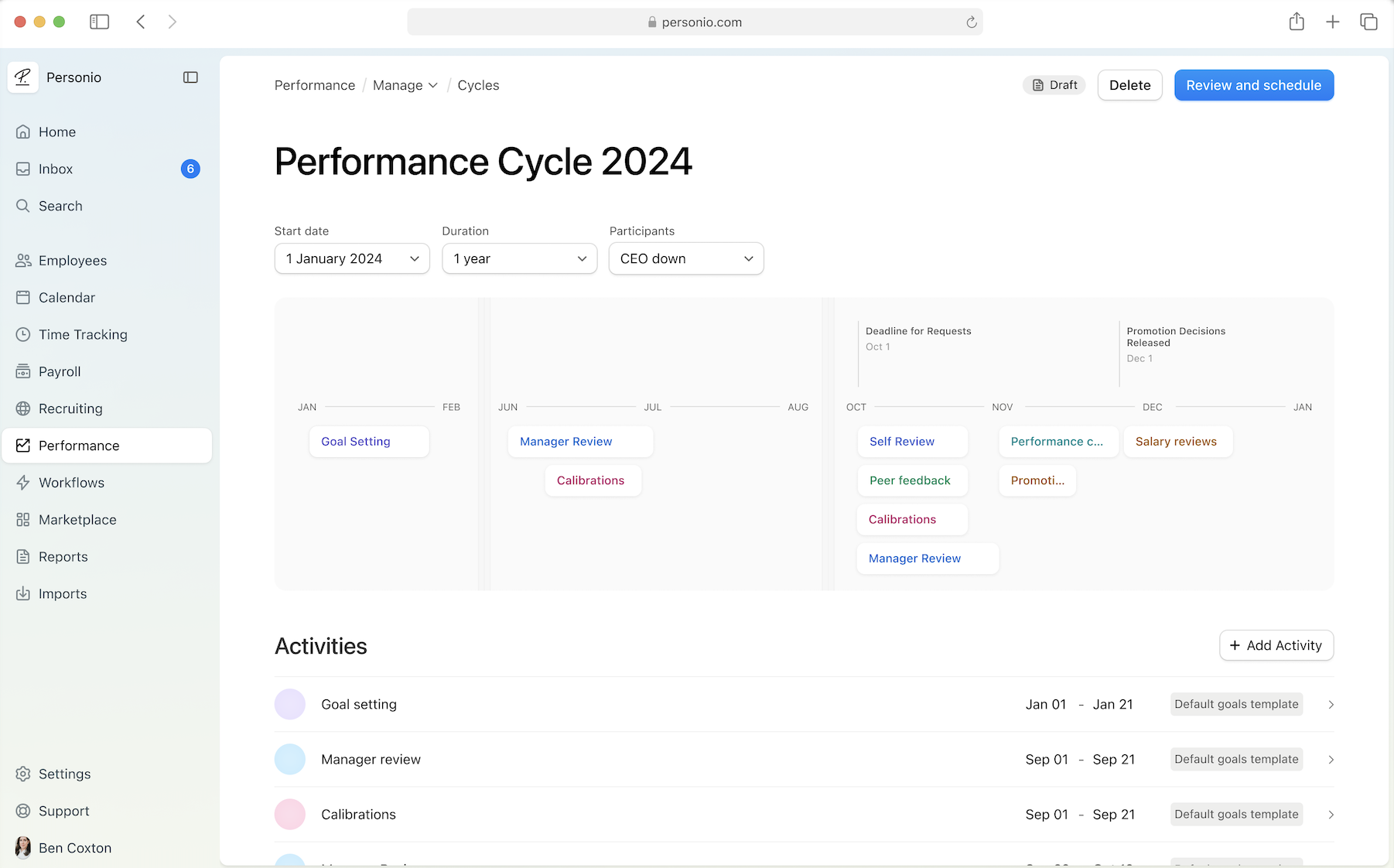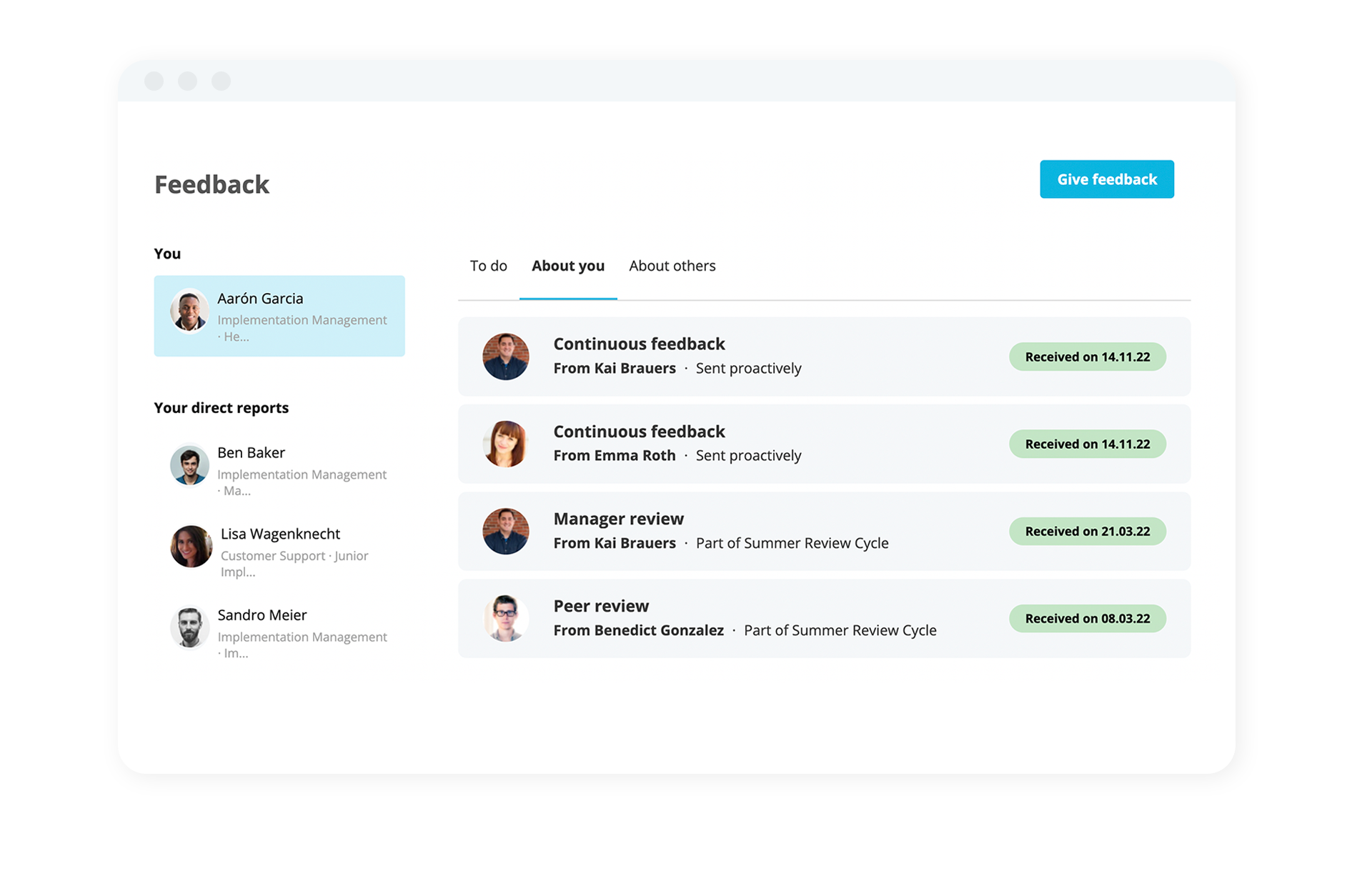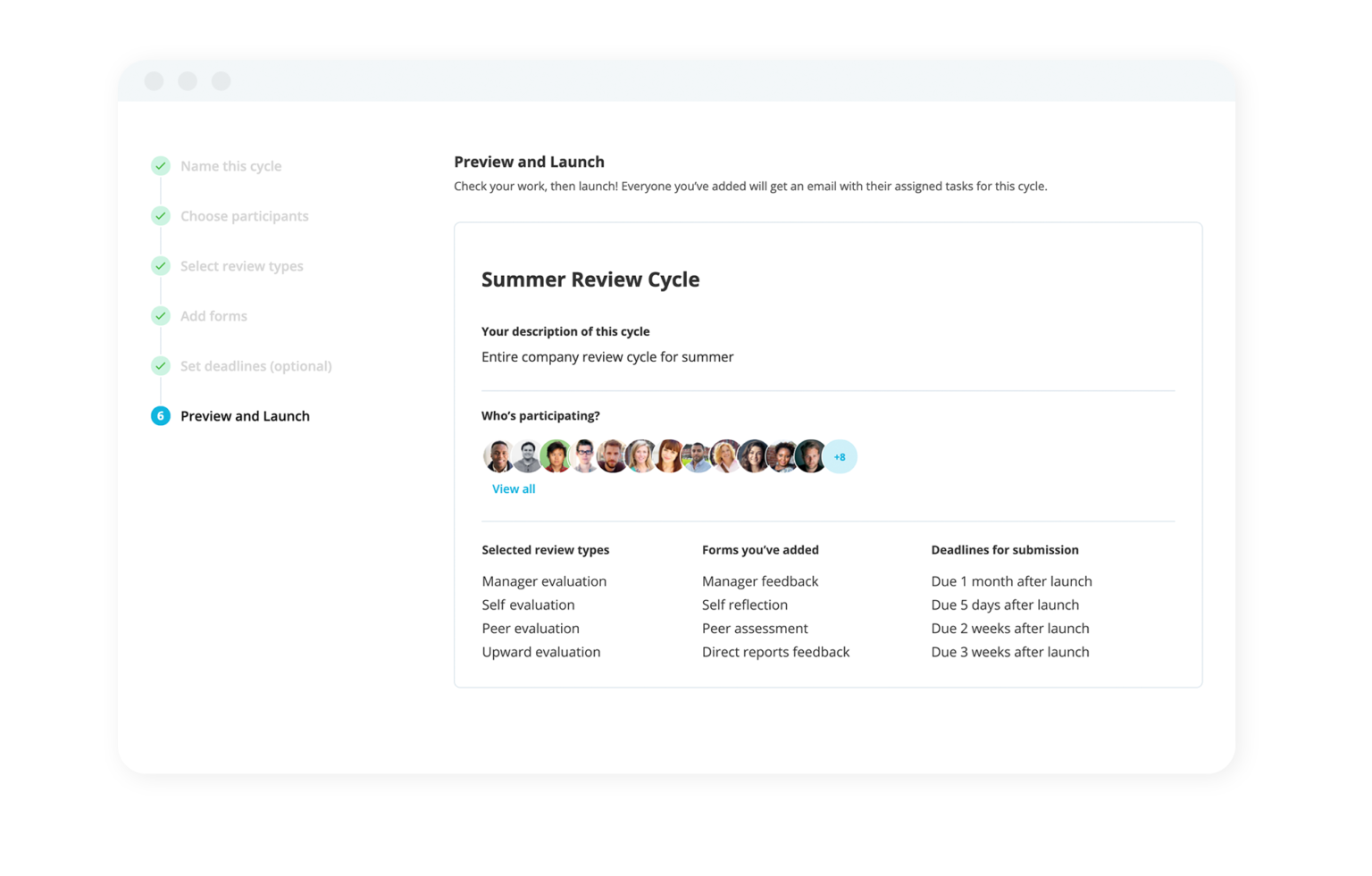
Centralise HR processes in a single platform
Create HR workflows and build better review cycles with Personio's intuitive performance management software
Find out moreExamples of Performance Appraisals in the Workplace

When hearing the term “staff appraisals”, people likely think of annual employee performance reviews – an anxiety-inducing process for many. But appraisals are typically more frequent check-ins, allowing for timely, actionable evaluations. And they don't have to be stressful and nerve-wracking, as long as managers know the best ways to relay feedback.
In this article, we will discuss the importance and benefits of performance appraisals, provide actionable tips, and offer examples tailored to different job roles. We will also address common performance issues, explain self-appraisals and SMART goal setting, touch on legal considerations and provide managerial techniques for conducting effective reviews.
Start from the top with our performance review template today.
The importance and benefits of performance appraisals
Many may wonder whether performance appraisals are all that important? The truth is that they can be absolutely key to motivating and communicating with employees. The following are several reasons that make performance appraisals crucial:
Improving productivity: Regular feedback helps employees understand their strengths and areas for improvement, leading to better performance.
Motivating employees: Recognition and constructive feedback can boost morale and motivation.
Providing feedback and promotion opportunities: Appraisals help identify high performers for promotions and development opportunities.
Improving employee confidence: Constructive feedback and recognition can enhance employee confidence.
Setting goals: Appraisals help employees set and achieve SMART (Specific, Measurable, Achievable, Relevant, Time-bound) goals.
Recording progress: Regular appraisals track employee progress and identify areas needing attention.
Aiding management decisions: Appraisals provide data to support decisions on promotions, training, and development.
Enhancing managerial skills: Appraisals help managers become better coaches and mentors.
Types of Performance Appraisals

Which types of performance appraisals exist? Your organisation has options when it comes to choosing how you run your appraisals. Here are some of the types that you may want to consider the most...
360-degree appraisal: Collects feedback from all the people who work with the employee, including subordinates, peers, supervisors, and customers.
Peer reviews: Involves colleagues evaluating each other’s performance.
Graphic rating scale: Rates workers on a numbered scale for their role’s desired traits and behaviours.
Ranking: Ranks each employee based on certain factors with high performers at the top and low performers at the bottom.
Checklist: Employees either receive a checkmark or don’t for the specified factors.
Grid: Uses the 9-box grid to plot employees and map out the state of the workforce.
Tips for using phrases and tailoring feedback
When providing feedback, it’s important to be specific, balanced and actionable. Here are some tips:
Be specific: Use clear examples to illustrate your points.
Balance feedback: Combine positive and constructive feedback.
Tailor feedback: Adjust your approach based on the employee’s role and personality.
Use actionable language: Provide clear steps for improvement.
Examples of performance appraisals
Choosing the right way to frame feedback during an appraisal can be tricky. You want to strike a balance between being honest and helpful but also inspiring motivation instead of dread.
In this section, we’ll offer managers and employers some suggestions for how to offer feedback during an appraisal based on some of the most common working “habits”. Here are examples of phrases you can use depending on if the area is a positive (strength) or negative (weakness) for the employee.
Creativity and innovation
Positive: Consistently finds innovative ways to tackle challenges. Inspires other team members to think creatively. Uses his/her creativity to improve every deliverable.
Negative: Rigid mindset does not enable creative thinking. Does not foster a creative or innovative work environment for his/her team. Lacks imagination to come up with innovative solutions.
Attendance
Positive: Always on time or early for meetings. Starts each day on time and ready to work. Sticks to the schedule whenever possible.
Negative: Is frequently late to work at the beginning of the day. Does not follow the company’s attendance policy. Poor attendance negatively impacts coworkers.
Teamwork
Positive: Has proven themselves to be a team player. Willing to offer advice and help to teammates at any time. Is considerate of others’ feelings and needs.
Negative: Does not treat the workplace as a team environment. Always wants to complete projects alone. Coworkers are hesitant to ask him/her for help or advice.
Leadership
Positive: Understands strengths and weaknesses of his/her team. Keeps team engaged and working toward mutual goals. Provides a great example for others to follow.
Negative: Does not inspire or motivate team members to work hard. Does not listen well or treat others as equals. Lacks clarity when assigning tasks and goals.
Time management
Positive: Uses time effectively to complete projects. Consistently meets all deadlines. Respects his/her coworkers’ time.
Negative: Frequently submits work late. Does not have a solid understanding of how long a task will take. Tends to exceed allotted time during meetings and presentations.
Communication skills
Positive: Effectively communicates with coworkers and managers. Responds to emails/messages/requests in a timely manner. Communicates his/her weekly progress to improve transparency.
Negative: Tends to become defensive during difficult conversations. Frequently takes several days to respond to emails. Does not communicate respectfully with coworkers.
Productivity
Positive: Exceeded expectations on goals during [time period]. Consistent top performer on the team. Develops effective strategies to deliver positive results.
Negative: Did not meet production goal defined during the last performance review. Does not try to go above and beyond. Is typically near the bottom for performance ratings.
Customer experience
Positive: Excels at creating a positive customer experience. Keeps calm when speaking with angry customers. High customer satisfaction rating.
Negative: Does not listen well to customers or help them overcome issues. Too often chooses to pass a customer complaint on to someone else in the team. Receives consistently low ratings on customer surveys.
Problem solving
Positive: Approaches new challenges with a positive attitude and a plan. Utilises all members of the team to solve problems. Excels at finding innovative solutions to hard problems.
Negative: Becomes easily discouraged by large problems. Lacks the long-term planning needed to solve problems. Tries to tackle challenges alone rather than involving the team.
Work ethic
Positive: Fosters an environment with high ethical standards for all team members. Consistently does the right thing even when it’s difficult. Ensures all deliverables are aligned with company values and guidelines.
Negative: Encourages other team members to mislead customers to win a sale. Does not act in accordance with company values. Often stretches the truth when speaking with managers.
Attitude
Positive: Always looks for the positive in any situation. Positive attitude improves the motivation of everyone on his/her team. Helps to lighten the mood during stressful times.
Negative: Switches too easily from a positive to a negative attitude. Negative attitude can affect others on the team. Needs to better control poor attitude.
Flexibility
Positive: Adapts to new situations and challenges easily. Willing to change style of working for the benefit of the greater team. Capable of handling a range of assignments at once.
Negative: Does not excel at projects requiring flexibility. Unwilling to admit when he/she is wrong. Resistant to unknown processes or trying new techniques.
Examples for different job roles and functions
When it comes to different departments in your organisation, you may need to evaluate your language and what makes sense for different professions. Consider the following...
Sales:
Positive: "Consistently exceeds sales targets and builds strong client relationships."
Negative: "Needs to improve follow-up with potential clients to convert leads."
Marketing:
Positive: "Develops innovative campaigns that drive engagement and brand awareness."
Negative: "Should focus on data analysis to measure campaign effectiveness."
IT:
Positive: "Efficiently resolves technical issues and supports team members."
Negative: "Needs to improve documentation of processes and solutions."
Addressing common issues with phrases
What about some of the most common issues that crop up in your everyday organisation? You can use this list as inspiration...
Attendance:
Issue: Frequently late to work.
Solution: Implement a flexible schedule or set clear expectations.
Phrase: "We need to address your punctuality to ensure team productivity."
Teamwork:
Issue: Prefers to work alone.
Solution: Encourage collaboration through team projects.
Phrase: "Let’s work on involving you more in team activities."
Time Management:
Issue: Frequently misses deadlines.
Solution: Provide time management training or tools.
Phrase: "Improving your time management skills will help you meet deadlines consistently."
Self-appraisals and SMART goal setting
Self-appraisals encourage employees to reflect on their performance and set goals. Use the SMART framework to set clear and achievable goals:
Specific: Define clear objectives.
Measurable: Set criteria for measuring progress.
Achievable: Ensure the goals are realistic.
Relevant: Align goals with company objectives.
Time-bound: Set a deadline for achieving the goals.
Legal considerations and seeking HR guidance
Performance appraisals must comply with employment laws to avoid discrimination and ensure fairness. Seek HR guidance to:
Ensure appraisals are consistent and unbiased.
Document appraisals accurately.
Address any legal concerns promptly.
Managerial techniques for conducting appraisals
Prepare thoroughly: Review the employee’s performance data and set clear objectives for the meeting.
Create a positive environment: Ensure the setting is comfortable and private.
Communicate clearly: Use specific examples and actionable language.
Listen actively: Encourage employees to share their perspectives.
Follow up: Set a plan for follow-up meetings and continuous feedback.
Balancing positive and negative feedback
Creativity & Innovation:
Positive: "Consistently finds innovative ways to tackle challenges."
Negative: "Rigid mindset does not enable creative thinking."
Leadership:
Positive: "Keeps team engaged and working toward mutual goals."
Negative: "Does not inspire or motivate team members to work hard."
Unconscious bias in performance appraisals
Unconscious bias can impact feedback and appraisals. To mitigate bias:
Awareness: Educate managers about unconscious bias.
Standardisation: Use standardised appraisal forms and criteria.
Diverse perspectives: Include multiple reviewers in the appraisal process.
Put Employee Performance In Focus

Top talent demands development. Make it a point of focus with Personio’s Performance Management software. Schedule automated cycles, document feedback, and more. Find the whole story by clicking below.
Drive Performance With PersonioUsing Personio to manage your appraisals

Personio’s HR software helps streamline the appraisal process:
Automate cycles: Schedule regular performance reviews.
Document feedback: Easily keep track of feedback and progress.
Customise templates: Access tailored templates for different roles and appraisal types.
Boost employee performance better appraisals
Performance appraisals require planning, nuance, and intentional language.
Employees should feel supported and managers should feel prepared so the whole organisation can benefit.
To learn more about tracking all your performance cycles and building ones that match your organisation’s culture, values and processes today, speak with an expert today.
